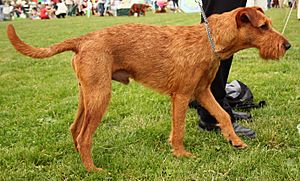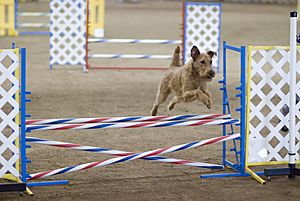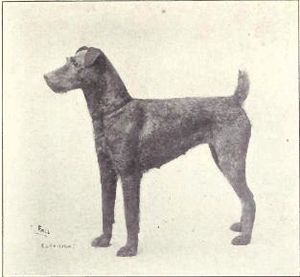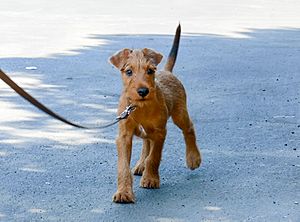Irish Terrier facts for kids

Irish Terrier in Sydenham Hill Woods, London
|
|||||||||||||||||||||||||
| Other names | Irish Red Terrier | ||||||||||||||||||||||||
|---|---|---|---|---|---|---|---|---|---|---|---|---|---|---|---|---|---|---|---|---|---|---|---|---|---|
| Origin | Ireland | ||||||||||||||||||||||||
|
|||||||||||||||||||||||||
|
|||||||||||||||||||||||||
| Domestic dog (Canis lupus familiaris) | |||||||||||||||||||||||||
The Irish Terrier (called Brocaire Rua in Irish) is a dog breed from Ireland. It is one of many types of terrier dogs. Many people think the Irish Terrier is one of the oldest terrier breeds around.
In 1873, the Dublin dog show was the first to give Irish Terriers their own special group. By the 1880s, these dogs were very popular. They were the fourth most liked breed in both Ireland and Britain.
The Irish Terrier is an active dog. It is also a good size for living in the countryside or in a city. Its rough, red coat helps protect it from all kinds of weather.
Contents
What Does an Irish Terrier Look Like?
Appearance and Shape
Dog experts describe the perfect Irish Terrier as "racy, red, and rectangular." "Racy" means the dog looks strong but not too heavy. "Rectangular" means its body shape is longer than some other terriers, like the Fox Terrier.
The Irish Terrier has a deep chest, which is a special feature. Its tail usually starts high up. It should not curl over its back. In some places, tails are shortened when puppies are very young. This is called "docking." Where docking is not allowed, judges look at how the tail is carried.
Their ears are small and fold forward. They sit just above the top of the head. The ears are often a bit darker than the rest of their fur.
Coat and Color
Irish Terriers can be golden red, red, or wheaten in color. Sometimes, people think only dark red is the right color. But wheaten coats are also correct. A small white patch on the chest is allowed, but no other white spots should appear. As they get older, some grey hairs might show up.
Their outer coat is rough and wiry. It should never feel soft, silky, or curly. This coat lies flat against the skin. It should not be so long that it hides the dog's true shape. The legs have longer hairs, but not as much as a Wire Fox Terrier. This means their coat needs regular trimming, which can cost money.
The inner coat, or undercoat, is also red. It is dense, meaning it's very thick. If you part the fur with your fingers, you should barely see the skin.
A well-groomed Irish Terrier has some longer hair on its legs and head. The hair on the front legs should look like even pillars. The chin has a small beard, but it's not as big as a Schnauzer's beard.
Their eyes are dark brown and quite small. They have a "fiery" look. The eyes are topped with neat eyebrows. The whole head should have good color.
Size and Weight
Most breed guides say an Irish Terrier should be no more than 48 centimeters (about 19 inches) tall at the shoulder. However, some females can be 50 cm (about 20 inches) tall. Males can even reach 53 cm (about 21 inches).
Original breed descriptions said they should weigh 11 to 12 kilograms (25–27 pounds). Today, it's common for females to weigh 13 kg (29 pounds) and males 15 kg (33 pounds).
Irish Terrier Personality and Training
Irish Terriers are very active dogs. They love challenges for their minds and bodies. Well-trained Irish Terriers can do well in dog sports like dog agility.
They are full of energy but not overly hyper. They can relax inside the house. But they can also quickly get ready for full activity.
Irish Terriers are usually good with people. They are very loyal. It's important for them to have a strong, kind leader they respect. Most Irish Terriers love children. They can handle a bit of rough play.
These dogs need daily exercise. Don't get one if you are not ready to walk it often. They enjoy training and learn new tasks easily. Food and toys work well to motivate them. They respond best to consistent training that uses rewards. Always use kindness, not force. It's best to outsmart them and reward the good things they do. If you get a trainer, find one who knows about terriers.
Irish Terriers can sometimes be bossy with other dogs. Like any dog, if they don't learn to be around other dogs when they are young, they might start fights. So, early training to be social is very important. Most Irish Terriers have strong guarding instincts. When these are managed well, they make great watchdogs that will alert you to strangers.
Many people now do dog sports with their terriers. Basic obedience training for sports is quite easy for them. Many Irish Terriers are great at dog agility. This sport needs speed, independence, and precision.
Irish Terriers have a good sense of smell. They can learn to track animals or people. Many enjoy Lure Coursing, which is chasing a fake lure. In Finland, one Irish Terrier is even a qualified Rescue Dog for sea rescues.
History of the Irish Terrier
We don't know exactly where the Irish Terrier came from. People believe they came from black and tan terrier-type dogs in Britain and Ireland. Other terriers like the Kerry Blue and Irish Soft-haired Wheaten Terriers also share this history. Some even think they might be related to the Irish Wolfhound.
An old Irish writer described them as "the poor man's sentinel, the farmer's friend, and the gentleman's favourite." These dogs were first bred for their working skills and bravery, not just their looks. They were excellent at catching pests. In the past, they came in many colors and sizes, like black-and-tan, grey-and-brindle, wheaten, and red. Their color or size didn't matter as long as they were tough and brave.
People started to carefully choose and breed them in the late 1800s. They were sometimes shown in dog shows.
The first club for the breed started in Dublin in 1879. The English Kennel Club recognized Irish Terriers as a native Irish breed just before the 1900s. They were the first terrier group to get this honor. The first Irish Terriers came to the United States in the late 1800s and quickly became popular.
Up until the 1960s, there were many important kennels in Ireland, Britain, and the US. Today, the breed is becoming more popular as a family pet. This is because they are so good with children. People are breeding them in many parts of the world, including Africa, North America, Europe, and Australia.
How to Care for an Irish Terrier
When an Irish Terrier's coat is cared for properly, it protects the dog from rain and cold. A well-groomed Irish Terrier also does not shed much hair. The wiry coat is quite easy to look after. Pet dogs usually only need their coat "stripped" once or twice a year.
"Stripping" means removing the old, dead outer hair by hand or with a special non-cutting knife. This does not hurt the dog if done correctly. It helps keep the coat strong and weather-resistant. You should never cut the coat with scissors or clippers. If you cut it, the color fades, and the coat becomes soft. This makes it lose its ability to protect the dog from weather.
For the same reason, you should not wash the coat too often. Soaps can remove the natural oils from the skin. Most Irish Terriers only need a bath when they are truly dirty.
When stripping, you can remove all the old hair. This leaves the dog with its soft undercoat until a new coat grows in. For a pet, this should be done at least twice a year. If you want a show-quality coat, it takes more work. One way is to "roll the coat," which means stripping small amounts of dead hair every few weeks. Before a dog show, an expert groomer shapes the head and legs.
Most Irish Terriers need their ears trained when they are young. This helps them fold forward correctly.
Irish Terrier Health
The Irish Terrier is generally a healthy dog breed. They usually live for about 13 to 14 years.
Their body shape is not extreme, so they rarely have eye or breathing problems. Most Irish Terriers do not have allergies to food. Since they are smaller dogs, they have very few cases of hip dysplasia. This is a problem with the hip joint.
In the 1960s and 1970s, some Irish Terriers had a disease called hyperkeratosis. This caused hard, painful pads on their feet. Today, breeders know which dogs carried this disease. Responsible breeders no longer use those bloodlines for breeding. A study by the Irish Terrier Club of America found a few cases of hypothyroidism (a thyroid problem) and cataracts (eye clouding). More research is needed on these issues.
Irish Terriers in Books and Movies
- Jack London wrote books like Jerry of the Islands and Michael, Brother of Jerry. These stories were about Irish Terriers. The dogs in the books might have been based on real ones.
- The 2007 movie Firehouse Dog stars an Irish Terrier as the main character.
- William Lyon Mackenzie King, a former Prime Minister of Canada, owned several Irish Terriers. They were all named Pat. He even held special meetings to "talk" with the first Pat after the dog passed away.
- The poet William Wordsworth wrote a poem called "Fidelity." It was about a loyal Irish Terrier named Foxey. Foxey stayed by her owner, Charles Gough, after he fell and died in the mountains.
- The University of Notre Dame used an Irish Terrier as its mascot until the 1960s. The dogs had different names, with the last one being Clashmore Mike. You can see two Irish Terriers carved in stone on a building at the university called Alumni Hall.
See also
 In Spanish: Terrier irlandés para niños
In Spanish: Terrier irlandés para niños







